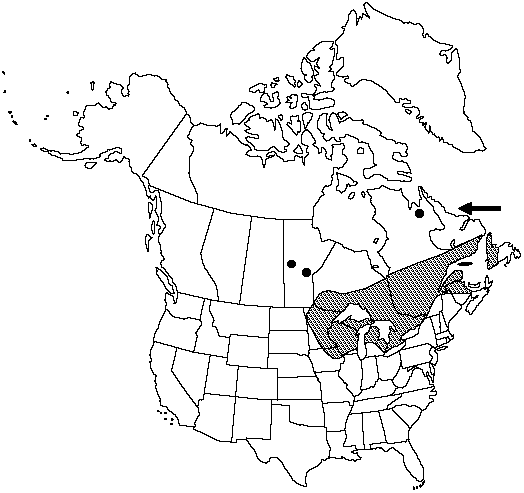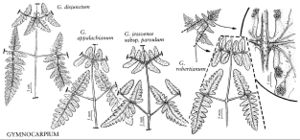Difference between revisions of "Gymnocarpium robertianum"
Phytologist 4: app. 24. 1851.
FNA>Volume Importer |
GeoffLevin (talk | contribs) m (Fixed Nfld. and Labr. distribution to match printed version.) |
||
| (3 intermediate revisions by 2 users not shown) | |||
| Line 8: | Line 8: | ||
}} | }} | ||
|common_names=Limestone oak fern;gymnocarpe de robert | |common_names=Limestone oak fern;gymnocarpe de robert | ||
| + | |special_status={{Treatment/ID/Special_status | ||
| + | |code=F | ||
| + | |label=Illustrated | ||
| + | }} | ||
|basionyms={{Treatment/ID/Basionym | |basionyms={{Treatment/ID/Basionym | ||
|name=Polypodium robertianum | |name=Polypodium robertianum | ||
| Line 40: | Line 44: | ||
|habitat=Calcareous substrates, limestone pavement, outcrops, and cliffs, Thuja swamps | |habitat=Calcareous substrates, limestone pavement, outcrops, and cliffs, Thuja swamps | ||
|elevation=0–1000 m | |elevation=0–1000 m | ||
| − | |distribution=Man.;N.B.;Nfld.;Ont.;Que.;Iowa;Mich.;Minn.;Wis.;Europe;Asia in Caucasus Mountains. | + | |distribution=Man.;N.B.;Nfld. and Labr.;Ont.;Que.;Iowa;Mich.;Minn.;Wis.;Europe;Asia in Caucasus Mountains. |
|discussion=<p><i>Gymnocarpium robertianum</i> occurs in numerous localities in eastern Canada, especially in Ontario and Quebec where it is widely distributed; populations are small. Hybrids with <i>G. robertianum</i> are extremely rare. <i>Gymnocarpium</i> × heterosporum W. H. Wagner, a putative triploid hybrid between <i>G. robertianum</i> and <i>G. appalachianum</i>, is known only from one county in Pennsylvania (plants now extirpated, K. M. Pryer 1992). <i>Gymnocarpium</i> × achriosporum Sarvela, a putative tetraploid hybrid between <i>G. robertianum</i> and <i>G. dryopteris</i>, is known only from Sweden and two localities in Quebec. Both hybrids resemble <i>G. robertianum</i> in their leaf morphology and dense glandularity but have black, malformed spores.</p> | |discussion=<p><i>Gymnocarpium robertianum</i> occurs in numerous localities in eastern Canada, especially in Ontario and Quebec where it is widely distributed; populations are small. Hybrids with <i>G. robertianum</i> are extremely rare. <i>Gymnocarpium</i> × heterosporum W. H. Wagner, a putative triploid hybrid between <i>G. robertianum</i> and <i>G. appalachianum</i>, is known only from one county in Pennsylvania (plants now extirpated, K. M. Pryer 1992). <i>Gymnocarpium</i> × achriosporum Sarvela, a putative tetraploid hybrid between <i>G. robertianum</i> and <i>G. dryopteris</i>, is known only from Sweden and two localities in Quebec. Both hybrids resemble <i>G. robertianum</i> in their leaf morphology and dense glandularity but have black, malformed spores.</p> | ||
|tables= | |tables= | ||
| Line 58: | Line 62: | ||
|habitat=Calcareous substrates, limestone pavement, outcrops, and cliffs, Thuja swamps | |habitat=Calcareous substrates, limestone pavement, outcrops, and cliffs, Thuja swamps | ||
|elevation=0–1000 m | |elevation=0–1000 m | ||
| − | |distribution=Man.;N.B.;Nfld.;Ont.;Que.;Iowa;Mich.;Minn.;Wis.;Europe;Asia in Caucasus Mountains. | + | |distribution=Man.;N.B.;Nfld. and Labr.;Ont.;Que.;Iowa;Mich.;Minn.;Wis.;Europe;Asia in Caucasus Mountains. |
|reference=None | |reference=None | ||
|publication title=Phytologist | |publication title=Phytologist | ||
|publication year=1851 | |publication year=1851 | ||
| − | |special status= | + | |special status=Illustrated |
| − | |source xml=https:// | + | |source xml=https://bitbucket.org/aafc-mbb/fna-data-curation/src/2e0870ddd59836b60bcf96646a41e87ea5a5943a/coarse_grained_fna_xml/V2/V2_42.xml |
|genus=Gymnocarpium | |genus=Gymnocarpium | ||
|species=Gymnocarpium robertianum | |species=Gymnocarpium robertianum | ||
Latest revision as of 22:29, 20 February 2024
Stems 1–2 mm diam.; scales 2–4 mm. Fertile leaves usually 10–52 cm. Petiole 5–33 cm, with numerous glandular hairs distally; scales 2–6 mm. Blade broadly deltate, 2–3-pinnate-pinnatifid, 5–19 cm, usually firm and robust, abaxial surface moderately to densely glandular, rachis densely glandular, adaxial surface moderately glandular. Pinna apex acute. Proximal pinnae 3–13 cm, ± perpendicular to rachis, basiscopic pinnules ± perpendicular to costa; basal basiscopic pinnules either sessile or stalked, pinnate-pinnatifid or pinnatifid, if sessile then with basal basiscopic pinnulet usually shorter than adjacent pinnulet; 2d basal basiscopic pinnule sometimes stalked, if sessile then with basal basiscopic pinnulet shorter than or equaling adjacent pinnulet; basal acroscopic pinnule sometimes stalked, if sessile then with basal basiscopic pinnulet shorter than or equaling adjacent pinnulet. Pinnae of 2d pair usually stalked, if sessile then with basal basiscopic pinnule usually shorter than adjacent pinnule and equaling basal acroscopic pinnule; basal acroscopic pinnule shorter than adjacent pinnule, apex often entire, rounded. Pinnae of 3d pair usually sessile with basal basiscopic pinnule shorter than adjacent pinnule and equaling basal acroscopic pinnule; basal acroscopic pinnule equaling or shorter than adjacent pinnule. Ultimate segments of proximal pinnae oblong, entire to slightly crenate, apex entire, rounded. Spores 34–39 µm. 2n = 160.
Habitat: Calcareous substrates, limestone pavement, outcrops, and cliffs, Thuja swamps
Elevation: 0–1000 m
Distribution

Man., N.B., Nfld. and Labr., Ont., Que., Iowa, Mich., Minn., Wis., Europe, Asia in Caucasus Mountains.
Discussion
Gymnocarpium robertianum occurs in numerous localities in eastern Canada, especially in Ontario and Quebec where it is widely distributed; populations are small. Hybrids with G. robertianum are extremely rare. Gymnocarpium × heterosporum W. H. Wagner, a putative triploid hybrid between G. robertianum and G. appalachianum, is known only from one county in Pennsylvania (plants now extirpated, K. M. Pryer 1992). Gymnocarpium × achriosporum Sarvela, a putative tetraploid hybrid between G. robertianum and G. dryopteris, is known only from Sweden and two localities in Quebec. Both hybrids resemble G. robertianum in their leaf morphology and dense glandularity but have black, malformed spores.
Selected References
None.
